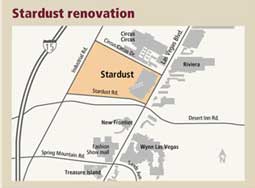<section class="article-header"> <header> The Next Las Vegas Megaresort Could Shift Power on The Strip
The north end of the Las Vegas Strip is now the hottest spot in town.
</header> </section> <section class="left-rail">
</section>

Venetian and Wynn Las Vegas used to be alone on the north end of the Las Vegas Strip. Now they're becoming the center of the action. Image owned by The Motley Fool.
A decade and a half ago, the land north of Caesars Palace and The Flamingo was the forgotten section of the Las Vegas Strip. Mirage was there, and Las Vegas Sands' (NYSE:LVS) The Venetian was just opening, and while the latter drew convention business it felt like it was a world away from The Strip's hottest hotels. Bellagio, Mandalay Bay, MGM Grand, and even New York-New York were the city's hottest properties, and the south end of The Strip seemed like it would be the center of Las Vegas for decades, especially with all of its development potential.
But the north end of The Strip got a boost from Wynn Resorts' (NASDAQ:WYNN) Wynn Las Vegas and Encore, and Las Vegas Sands added Palazzo to its property. Meanwhile, some of the casinos on the south side slowly deteriorated; now if you have a lot of money to spend in Las Vegas, you are more than likely going to stay at the Bellagio or north.
The tectonic shift in The Strip's core may not be over, either. The next megaresort is being built across the street and a block north of Wynn Las Vegas, pulling most well heeled visitors even further north. And it's shifting the power on the Las Vegas Strip. For investors, the trend is worth keeping an eye on.
Location, location, location
The truth in Las Vegas is that a single resort's potential is only as good as its surroundings. The Palms, which was the hottest resort in town for a few years, didn't have much staying power and ran into financial trouble in 2010. Stratosphere has gone through bankruptcy, and Downtown Las Vegas has had a long history of financial trouble. So being in the center of the action is key for casinos.
In the 1990s and early 2000s, MGM Resorts (NYSE:MGM) and Caesars Entertainment (NASDAQ:CZR) merged with competitors and acquired as many resorts as they could from the intersection of Flamingo Road and Las Vegas Boulevard south. The result was a critical mass of casinos from Treasure Island to Mandalay Bay.
But that critical mass of resorts soon began aging, and while the consolidation was going on, Wynn Resorts and Las Vegas Sands were building the new high-end future of Las Vegas on the north end of The Strip. If the numbers below are any indication, they're putting the south end of The Strip to shame.
The north end of the Las Vegas Strip is now the hottest spot in town.
</header> </section> <section class="left-rail">
</section>

Venetian and Wynn Las Vegas used to be alone on the north end of the Las Vegas Strip. Now they're becoming the center of the action. Image owned by The Motley Fool.
A decade and a half ago, the land north of Caesars Palace and The Flamingo was the forgotten section of the Las Vegas Strip. Mirage was there, and Las Vegas Sands' (NYSE:LVS) The Venetian was just opening, and while the latter drew convention business it felt like it was a world away from The Strip's hottest hotels. Bellagio, Mandalay Bay, MGM Grand, and even New York-New York were the city's hottest properties, and the south end of The Strip seemed like it would be the center of Las Vegas for decades, especially with all of its development potential.
But the north end of The Strip got a boost from Wynn Resorts' (NASDAQ:WYNN) Wynn Las Vegas and Encore, and Las Vegas Sands added Palazzo to its property. Meanwhile, some of the casinos on the south side slowly deteriorated; now if you have a lot of money to spend in Las Vegas, you are more than likely going to stay at the Bellagio or north.
The tectonic shift in The Strip's core may not be over, either. The next megaresort is being built across the street and a block north of Wynn Las Vegas, pulling most well heeled visitors even further north. And it's shifting the power on the Las Vegas Strip. For investors, the trend is worth keeping an eye on.
Location, location, location
The truth in Las Vegas is that a single resort's potential is only as good as its surroundings. The Palms, which was the hottest resort in town for a few years, didn't have much staying power and ran into financial trouble in 2010. Stratosphere has gone through bankruptcy, and Downtown Las Vegas has had a long history of financial trouble. So being in the center of the action is key for casinos.
In the 1990s and early 2000s, MGM Resorts (NYSE:MGM) and Caesars Entertainment (NASDAQ:CZR) merged with competitors and acquired as many resorts as they could from the intersection of Flamingo Road and Las Vegas Boulevard south. The result was a critical mass of casinos from Treasure Island to Mandalay Bay.
But that critical mass of resorts soon began aging, and while the consolidation was going on, Wynn Resorts and Las Vegas Sands were building the new high-end future of Las Vegas on the north end of The Strip. If the numbers below are any indication, they're putting the south end of The Strip to shame.









